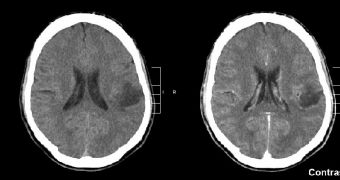Glioma is one of the most dangerous types of brain tumors out there today, for the simple fact that it is deadly and also spreads very fast. In addition to this, it also appears able to inactivate drugs aimed at inhibiting its growth, and a team of US researchers has recently determined how the cancer does that. Details of its groundbreaking discovery appear in the January 18 online early issue of the respected journal Proceedings of the National Academy of Sciences (PNAS).
Scientists at the Ludwig Institute for Cancer Research (LICR), an organization based at the University of California in San Diego (UCSD) School of Medicine, worked together with experts from the Moores UCSD Cancer Center for this investigation. The team says that most drugs used to fight glioma are aimed at inhibiting the action of the epidermal growth factor receptor (EGFR), which is a key cell signaling proteins that the cancer needs to grow. The tumor can evade these medications cunningly, the researchers add, and say that a significant, related finding shows that EGFR is also one of the main factors involved in promoting the onset, development, and “maintenance” of gliomas in the brain.
“The results suggest that the expression of EGFR is required for tumors to keep growing, and we've shown for the first time that there are mechanisms that the tumor is using to circumvent the need for the receptor. We need to find out more about the signaling pathways that brain tumors use to get around targeted therapeutics, such as those directed at EGFR,” UCSD School of Medicine Associate Professor of Medicine, Frank Furnari, PhD, says. He adds that the work may also hold value for other types of rapidly developing cancers as well that may be employing similar tactics in avoiding the effect of drugs.
But an additional discovery made during this study may break the blockage in finding new targets for glioma therapy. In mice studies, the researchers noticed that, even when EGFR was inhibited, some tumors grew. They hypothesized that another gene must be at work to promote the cancer, and used microarray technologies to find it. The culprit was identified as a gene called KLHDC8, which was over-expressed in the gliomas that had their EGFR protein inhibited, and under-expressed in normal circumstances.
“That finding makes us think that this gene would be a reasonable target. About half of the individual tumors that didn't need mutant EGFR to grow expressed that gene and, if we silenced the gene, those tumors did not grow,” LICR Branch Director and Medicine Professor Webster Cavenee, PhD, says. “If the tumors use the same strategy to get around receptor inhibitors, then targeting that alternate pathway plus the receptor up front should give a longer response because it's hitting the primary event plus the escape route,” the expert concludes.

 14 DAY TRIAL //
14 DAY TRIAL //